Calling all quacks! Quedlinburg is hosting its annual festival, and all the miracle doctors are at work mixing potions—but be careful not to blow up your pot!
What Is The Quacks of Quedlinburg?
The Quacks of Quedlinburg is a bag-building, press-your-luck game by Wolfgang Warsch for 2 to 4 players, ages 10 and up, and takes about 45 minutes to play. It was originally published by Schmidt Spiele in Europe, and is being distributed in the USA by North Star Games. It retails for $54.99, and is available in stores and online; it has been selling out quickly, but another print run should be coming later this month, and then another in August. The age rating seems about right, though you may be able to push that to about 8 years old; less experienced players may have a little more trouble with the strategy, but the rules are fairly easy to learn.

The Quacks of Quedlinburg Components
Here’s what comes in the box:
- 4 Pot boards
- 4 Bottles
- 4 Bags
- 8 Drop tokens
- 4 Rat Stone tokens
- 4 Victory Point tokens
- 4 Seal tokens
- 1 Scoreboard
- 1 Flame token
- 24 Fortune Telling cards
- 20 Rubies
- 12 Ingredient Books
- 219 Ingredient chips (varying amounts in 8 colors)
- 1 Bonus die
The components are colorful and fun to look at, though I did have some legibility issues in some areas. In particular, the white numbers on the white chips can be hard to see at a glance, and sometimes the white and green chips can be hard to spot on the light green pot boards.

The pot board itself provides a top-down look at a large pot (with a wooden spoon handle sticking out of it), and then various things on the table: a pouch for your rubies, a bowl for your rat stone, and a silver tray for your potion bottle. The pot boards are also double-sided, with an advanced side on the back. The scoreboard is also nicely designed, with a round tracker in the middle and some graphics that remind you about all of the steps to take after the potions phase.

The ingredient books are some of the most fun components: they’re cardboard tiles, die-cut to look like open books, and each one shows one of the ingredients, the cost to purchase the chips, and what it does. There are actually four versions of most of the ingredients, distinguished by the number of ribbon “bookmarks” shown sticking out of the page; it’s a clever way to change up the effects and abilities in the game without having to make more ingredient chips.
The bags are a thin fabric; it’s a nice material but seems a little too thin and flexible for me. The bags are plenty large enough so that you can put your hand inside to draw chips out, but the chips can clump up and get stuck in the corners because of the way the fabric folds up.
 The Quacks of Quedlinburg is GeekDad Approved!
The Quacks of Quedlinburg is GeekDad Approved!
How to Play The Quacks of Quedlinburg
You can download a copy of the rulebook here.
The Goal
The goal of the game is to score the most points by successfully creating potions in your pot.

Setup
Give each player a pot board, with the matching tokens and bottle. One droplet token is placed on the “0” space at the center of the board. The rat stone is placed in the bowl, and the potion bottle is placed (colored side up) on the silver tray. If you’re playing with the advanced side of the board, the second droplet token is placed on the empty test tube on the far left. (Otherwise, the second droplet token will not be used.)
The scoreboard and ingredient books are placed in the center of the play area, along with the ingredient chips. The black ingredient book has one side for 2 players and one for 3 or 4 players; the orange ingredient book only has one option. For all the other colors, there are four options (on 2 books): choose which set you’d like to use, and lay out those ingredient books.
The flame token is placed on the leftmost lamp on the scoreboard; it is used to track the 9 rounds of the game. Scoring markers are placed near the scoreboard, and each player puts a seal token on the scoreboard in the space provided—these say “0” on one side, and “50” on the other if you wrap all the way around the score track.
Shuffle the fortune teller cards and set them nearby. (Technically the rulebook says that the deck is rotated among the players and indicates the starting player, but there are only a couple cards that are actually affected by turn order, so I usually just leave it near the scoreboard.)
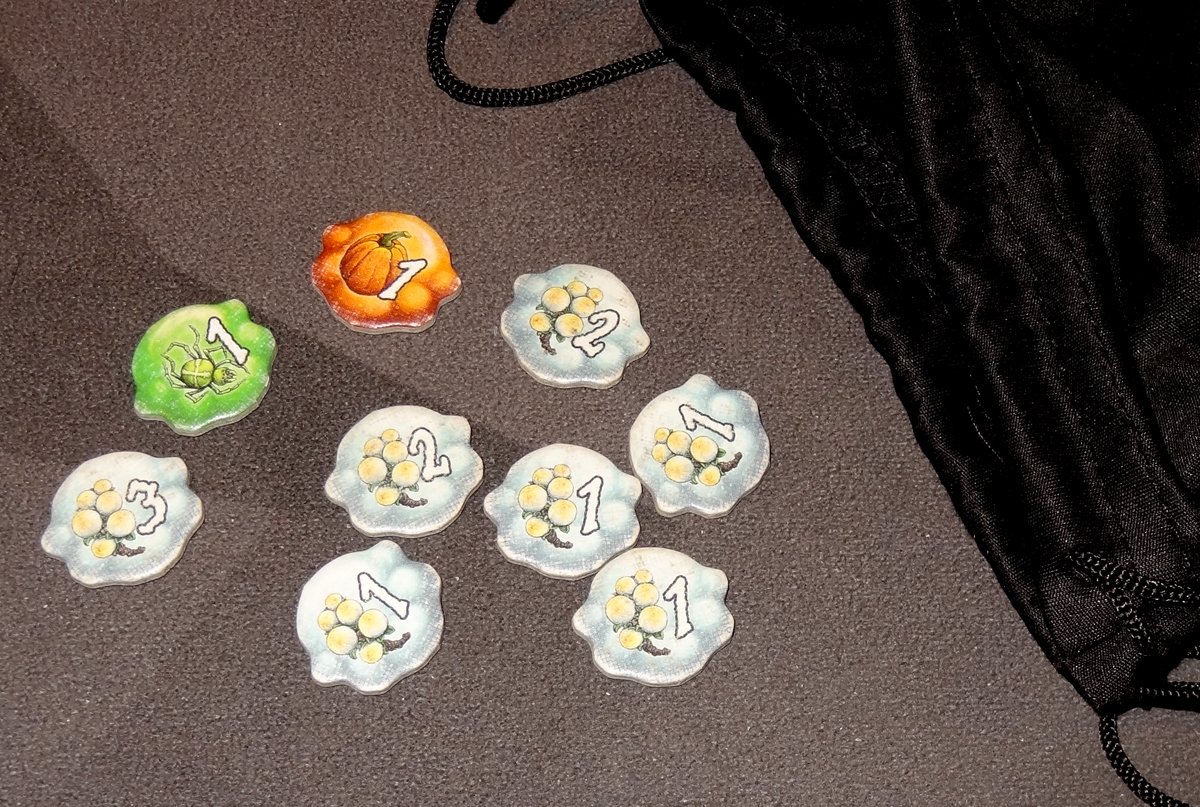
Each player starts with the following chips in their bag. (There’s a reminder of this on the basic side of the pot board.)
- 1 green 1-chip
- 1 orange 1-chip
- 4 white 1-chips
- 2 white 2-chips
- 1 white 3-chip
(Most of the chip colors have various denominations from 1 to 4.)

Gameplay
Fortune Teller Cards
At the beginning of each round, flip the top fortune teller card. Purple cards take effect immediately, and blue cards apply for the whole round or have an effect at the end of the round. The cards affect all players, not just the starting player.

Rat Tails
Then, you calculate rat tails (but only in the second round, when players have scored some points). You compare your score to the player in first place, and count how many rat tails are between you on the scoring track. For instance, in the photo above, the red player would have 6 rat tails, but the blue player only has 3 rat tails. The green player, in first place, has no rat tails. Count that number of spaces from your droplet token on your pot board, and place your rat stone on that space. When you draw chips from your bag, you will start counting from your rat stone instead of your droplet.
Potions Phase
Then it’s time to prepare your potions. Everyone can play this part of the round simultaneously.
Draw chips from your bag one at a time and place them into your pot. You start at your droplet token (or your rat stone, if it’s on the board), count a number of spaces equal to the chip’s value, and then place it onto the board. Each chip starts its count from the most recently placed chip, spiraling toward the edge of the pot.
Blue, red, and yellow chips have effects that occur as soon as they’re placed into your pot—see the ingredient books for their effects. Purple, green, and black chips have effects at the end of the round. (Orange chips have no effects.)
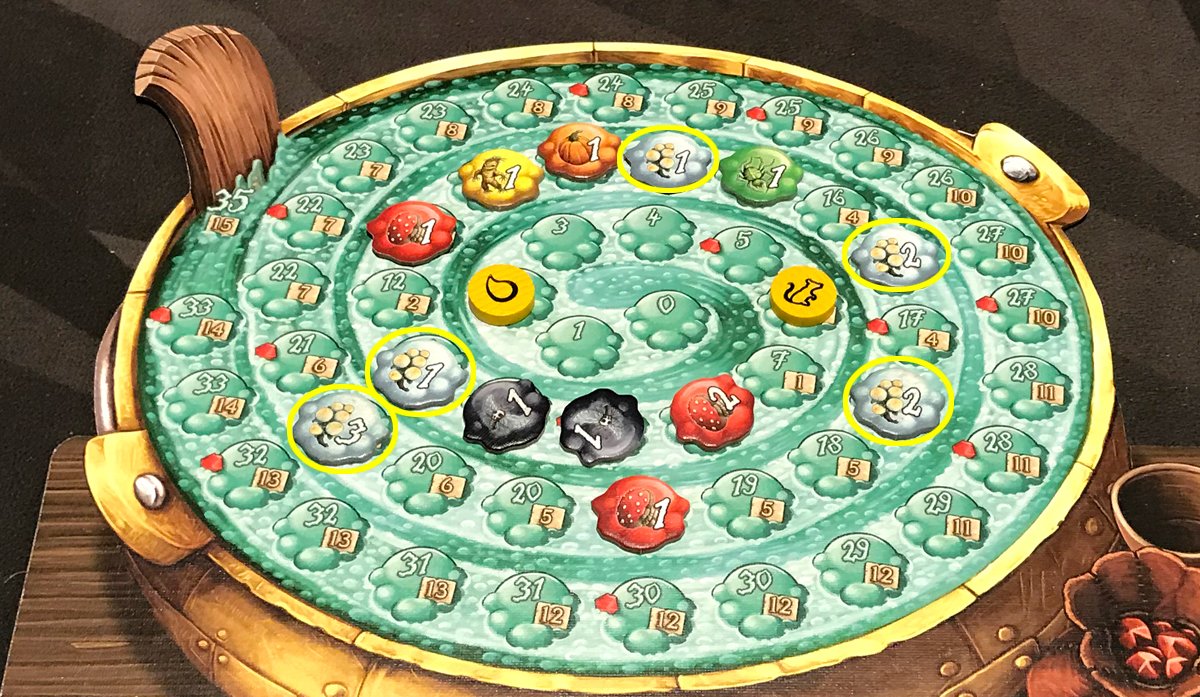
If your white chips (the “cherry bomb” ingredient) ever add up to more than 7, your pot explodes and you must stop drawing chips, and will suffer a penalty: you will earn points or money this turn, but not both. In the photo above, the last chip placed was the white “3,” bringing my total to 9, so my pot exploded. You may use your potion to put a white chip back into the bag right after you place it, but only if it didn’t cause your pot to explode. Then your potion bottle is flipped over to its blank side, and cannot be used until you refill it.

Once you decide to stop drawing chips (or your pot exploded), the next space on your pot board is your scoring space. The small number in the square is the points you’ll score, and the larger number at the top of the bubble is the money you earn. Some spaces also have a ruby next to them—these will earn you a ruby.

Evaluation Phase
After all players have stopped drawing chips, you move to the evaluation phase. At the bottom of the scoring track, there’s a list of steps to take:
- The player who reached the highest scoring space rolls the bonus die and gets the effect. If your pot exploded, you do not qualify for the bonus die; in case of a tie, all tied players roll. The die can give you points, an orange chip, a ruby, or move your droplet forward one space.
- Green, Purple, and Black chips take their effects now.
- If your scoring space has a ruby next to it, you gain 1 ruby.
- You score points equal to your scoring space.
- You may buy chips with the money you earned this turn according to your scoring space. You may buy up to 2 chips, and you may not buy 2 chips of the same color. Any money you do not spent is forfeit.
- You may spend any number of rubies: each pair of rubies moves your droplet forward 1 space or refills your potion bottle.
At the end of the round, move the flame ahead to the next space, return all rat stones to their bowls, and rotate starting player. Some of the lamps on the round track have some icons on them: yellow ingredients are not available to purchase until round 2; purple ingredients aren’t available until round 3; at the start of round 6, everyone adds a white 1-chip to their bag.
Clear off all of the chips from your pot and place them (along with any chips you purchased) back into your bag.
Game End
The game lasts for nine rounds. On the last round, players should draw one chip at a time simultaneously: everyone puts their hands into the bag, and draws out a chip at the same time. If you decide to stop, you just pull your hand out of the bag without a chip. This continues until everyone has stopped or exploded.
Also, at the end of the last round, you may spend money and rubies on points: each point costs 5 coins or 2 rubies.
The player with the highest score wins and is the biggest quack of Quedlinburg; in case of a tie, the player who reached the farthest space on the last round wins.
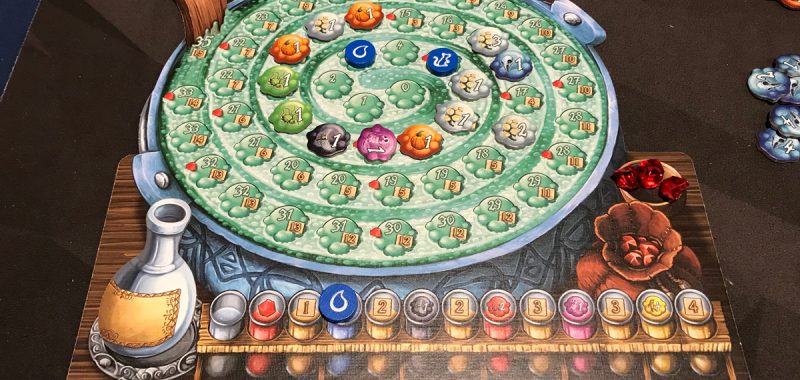
Advanced Variant
Aside from choosing a different set of ingredient books, you can also change up the game by using the reverse side of the pot boards. This side includes a row of test tubes along the bottom of the board. At the start of the game, you place your second droplet token in the first test tube, which is empty.
Every time you get to move your droplet, you may move either droplet one space. If you move the test tube droplet, you immediately gain the bonus shown in the test tube. Bonuses include a ruby, points, or various ingredient chips.

Why You Should Play The Quacks of Quedlinburg
I’d been hearing good things about The Quacks of Quedlinburg since last year, when it was nominated for (and eventually won) the Kennerspiel des Jahres, the “Connoisseur’s Game of the Year” award, but I had to wait until March this year to get a copy, when North Star Games brought it to the US. For me, it lives up to the hype: I always like press-your-luck games, and the bag-building aspect of Quacks is similar to deck-building, one of my favorite genres, so it’s a great blend of flavors that I already enjoy.
It’s just a lot of fun to pull chips from your bag, hoping not to explode. While you may not always remember all the ingredients you’ve purchased, you know exactly how many white chips are in your bag and what their values are. So if you’re up to 6 cherry bombs and you’re thinking “Well, the only chip left in here that could make me explode is my ‘3’ chip…” then it’s almost guaranteed that your fingers will somehow manage to find that white 3-chip mixed into the dozen other chips that are left in your bag.
I do like that exploding your pot isn’t the end of the world: unlike many press-your-luck games, you don’t lose everything when you bust. In Quacks, you lose a chance to roll the bonus die, but you can still earn rubies, you still get to use the effects of the purple, green, and black ingredients, and you can still get points or money. Early in the game, it’s a pretty easy decision: you really want to get more ingredients, and you may have only gotten a couple points anyway. Later in the game, however, you might want to forfeit buying more chips just to take the points.
The rat tails also make for an interesting catch-up mechanic. The further behind you are, the more rat tails you get, and so the further ahead you’ll start in your pot for that turn. It doesn’t guarantee that you’re going to catch up (particularly if you explode your pot anyway), but it does give you at least a fighting chance to score a little higher this round. There’s some debate about the runaway leader problem—somebody who scores well early on will get the bonus die, plus they had more money to spend on ingredients, which means they’re less likely to bust in later rounds and will continue to score more points and money. On the other hand, being behind by a few points (just enough to earn a few rat tails) can give you a boost because you can get farther even if you’re not able to draw as many chips. If you get far enough behind, though, having a whole lot of rat tails may still not make up for drawing very few chips before you bust.
For me, since it’s a fairly light press-your-luck game, I think I don’t usually mind as much: I’ve played very well and I’ve played very poorly, but I’ve had fun every time I’ve played, and that’s the reason I give it our GeekDad Approved seal.

Aside from knowing when to stop pulling chips, the bag-building aspect is the other key part of the strategy. What chips do you spend your money on? Each one has different effects, and of course the higher value chips (which move further on the track) cost more money. I really like the way that you can change up the game simply by using a different set of ingredient books. For instance, the level 1 toadstool has the ability that it will move 1 or 2 extra spaces, depending on how many orange chips you’ve already placed in your pot. So with that set of ingredients, you’ll want to get some extra pumpkins because they’ll boost your toadstools. The level 4 toadstool, on the other hand, boosts your white chips: if you have any red chips in your pot, then every white chip moves 1 extra space. In this case, having more than one red chip doesn’t move things any further, but they just increase the chances that you’ll draw a red chip before your white chips come out.
I really like the various different effects of the ingredients. Some give you more rubies, some let you earn points, some let you peek at a few chips and decide whether to use them, some move things further. Every player seems to have their favorite ingredients to use. Of course, just because you bought it and put it in your bag doesn’t mean it’ll ever see the light of day!
I took Quacks to GameStorm this year, and it was one of the games that was played the most during the weekend—I taught it several times myself, and saw my copy being taught by other players many times, too. The combination of easy-to-learn mechanics and the hilarity of impossibly bad luck are a potent brew.
If you enjoy press-your-luck games, and particularly if you enjoy deck-building games, I highly recommend checking out The Quacks of Quedlinburg!
Click here to see all our tabletop game reviews.
![]() To subscribe to GeekDad’s tabletop gaming coverage, please copy this link and add it to your RSS reader.
To subscribe to GeekDad’s tabletop gaming coverage, please copy this link and add it to your RSS reader.
Disclosure: GeekDad received a copy of this game for review purposes.
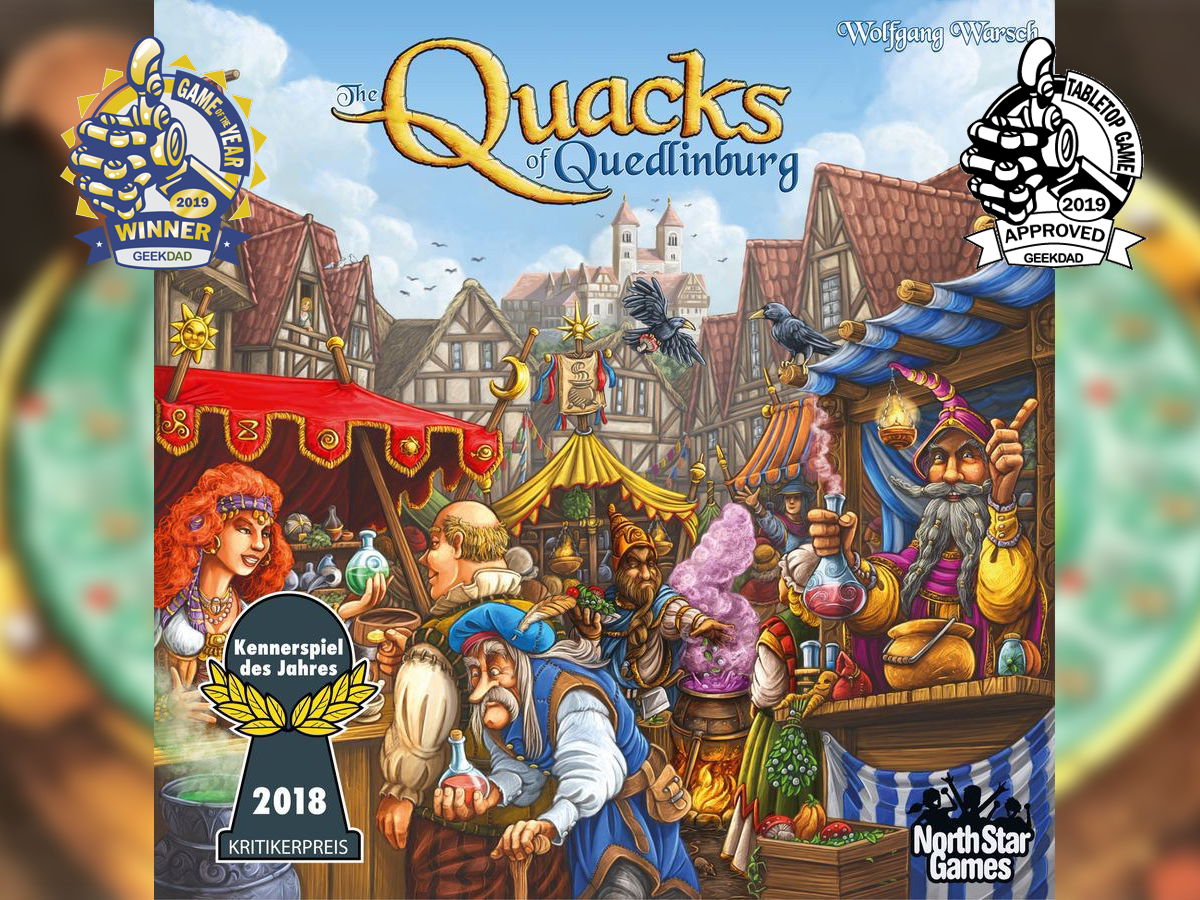


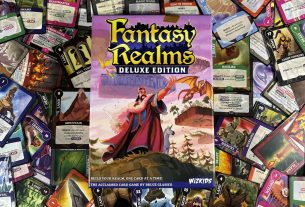

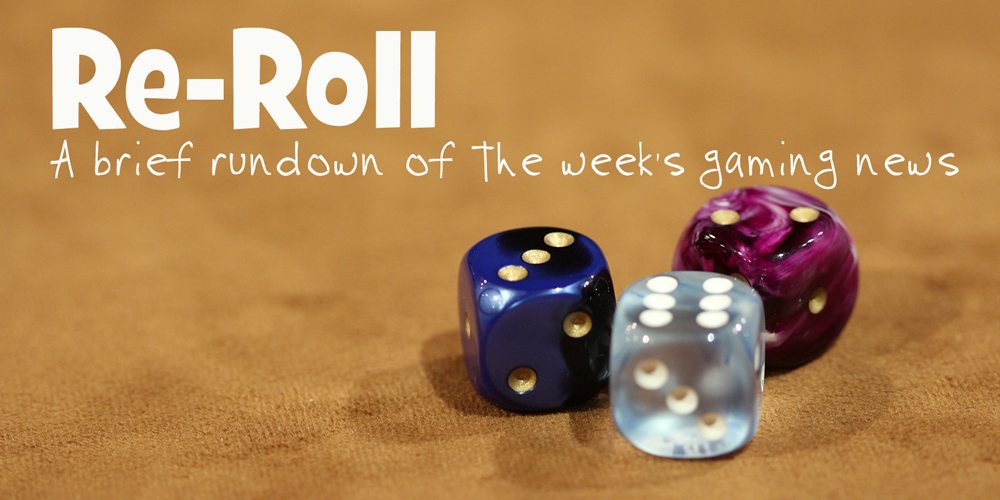
It’s a terrific game, but I’ve found that it benefits from a couple of inexpensive “quality of life” upgrades. First, I purchased a $9 set of velvet tarot card bags off of Amazon.com. The bags that come with the game frequently get tokens caught in the corners; this doesn’t happen with the velvet bags. (For those that don’t want to spend any money, I’ve heard that sewing up the corners of the bags that come with the game and turning them inside out also works). Secondly, I got a DVG deepdish bookcase game counter tray to hold all the tokens(as well as the rubies and die). This creates a convenient “bank” for the tokens, and makes setup and teardown of the game go 10x faster. Plus, if you remove the insert from the game box, the tray and all of the other components fit easily inside the box.
I’ve seen some people using plastic coin protectors for the ingredient chips, too, or buying the upgraded wooden tokens—those all seem to make the chips more visible on the board and less likely to snag in the corners of the bags, too. I haven’t invested in any of that yet myself, but will keep those in mind!